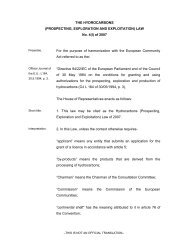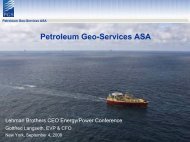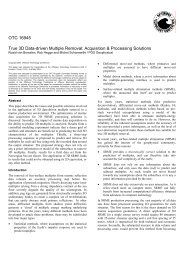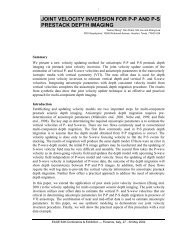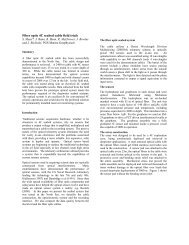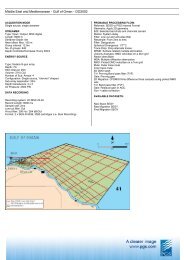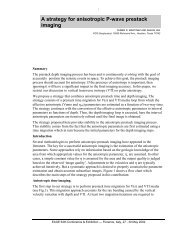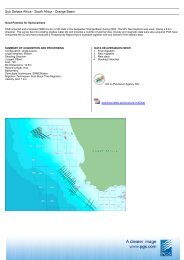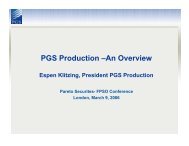Annual Report 2011 - PGS
Annual Report 2011 - PGS
Annual Report 2011 - PGS
You also want an ePaper? Increase the reach of your titles
YUMPU automatically turns print PDFs into web optimized ePapers that Google loves.
Notes to the consolidated financial statements<br />
NOTES TO THE CONSOLIDATED FINANCIAL STATEMENTS<br />
Amortization of the MultiClient library is generally recorded in proportion to revenue recognized in a period as a percentage of<br />
the total remaining expected revenue. On an annual basis the Company categorizes each MultiClient survey into one of four<br />
amortization categories with amortization rates of 90%, 75%, 60% or 45% of sales. Classification of each project into a rate<br />
category is based on the ratio of its remaining net book value to estimated remaining sales. Each category therefore is<br />
comprised of surveys for which the remaining book value as a percentage of estimated remaining sales is less than or equal to<br />
the amortization rate applicable to that category.<br />
An integral component of amortization of the MultiClient library is the minimum amortization policy. Under this policy, the book<br />
value of each survey or group of surveys of the MultiClient library is reduced to a specified percentage by year-end, based on<br />
the age of the survey or group of surveys in relation to its year of completion. This requirement is applied each year-end<br />
regardless of future sales estimates for the MultiClient library survey or groups of surveys. The specified percentage generates<br />
the maximum permitted book value for each MultiClient library survey or group of surveys as the product of the percentage<br />
multiplied by the original book value of the MultiClient library survey or group of surveys at the respective period end. Any<br />
additional or “minimum” amortization charges required are then determined through a comparison of the remaining book value<br />
to the maximum permitted book value allowed for each survey or group of surveys of the MultiClient library.<br />
The specified percentages used to determine the maximum book value of its MultiClient library components are summarized as<br />
follows:<br />
Calendar year<br />
after project completion<br />
5-year<br />
profile<br />
3-year<br />
profile<br />
Year 0 (a) 100% 100%<br />
Year 1 80% 66%<br />
Year 2 60% 33%<br />
Year 3 40% 0%<br />
Year 4 20%<br />
Year 5 0%<br />
(a) Represents the year in which the survey is classified as completed.<br />
All Marine MultiClient projects have a 5-year profile starting in the year after project completion. All derivative processed<br />
products have a 3-year profile starting in the year after data delivery. Derivative products are mainly reprocessing that creates<br />
data that can be sold as a separate project.<br />
The Company classifies as amortization expense in its consolidated statements of operations any impairment of individual<br />
MultiClient surveys that are based on changes in project specific expectations and that are not individually material. The<br />
Company expects this additional, non-sales related, amortization expense to occur regularly because each individual project is<br />
evaluated at least annually for impairment or when specific indicators exist. The Company classifies as impairment in its<br />
consolidated statements of operations write-downs related to fundamental changes in estimates affecting a larger part of the<br />
Company’s MultiClient library where the effects are material, see impairment of property, equipment and intangibles below.<br />
Research and development costs<br />
Research costs are expensed as incurred. An internally generated intangible asset arising from development (or from the<br />
development phase of an internal project) is recognized if, and only if, all of the following have been demonstrated: the technical<br />
feasibility of completing the intangible asset so that it will be available for use or sale; the intention to complete the intangible<br />
asset and use or sell it; the ability to use or sell the intangible asset; how the intangible asset will generate probable future<br />
economic benefits; the availability of adequate technical, financial and other resources to complete the development and to use<br />
or sell the intangible asset; and the ability to measure reliably the expenditure attributable to the intangible asset during its<br />
development.<br />
The amount initially recognized for internally generated intangible assets is the sum of the expenditure incurred from the date<br />
when the intangible asset first meets the recognition criteria listed above. Where no internally generated intangible asset can be<br />
recognized, development costs are expensed as incurred.<br />
Subsequent to initial recognition, internally generated intangible assets are reported at cost less accumulated amortization and<br />
accumulated impairment losses, on the same basis as intangible assets acquired separately. Capitalized development costs are<br />
amortized on a straight line basis over the estimated useful life.<br />
Patents, licenses and technology<br />
Patents, licenses and technology are stated at cost less accumulated amortization and any impairment charges. Amortization is<br />
calculated on a straight-line basis over the estimated period of benefit, ranging from one to twenty years.<br />
Exploration expenses<br />
The Company obtains ownership of oil and gas properties in exchange for providing acquisition services and licenses. These<br />
assets are capitalized as exploration expenses and are initially measured at the fair value of the received asset. The Company<br />
uses the “successful efforts” method of accounting for exploration expenses. Expenditures to acquire mineral interests in oil and<br />
gas properties are capitalized within intangible assets until the well is complete and the results have been evaluated. If,<br />
following evaluation, the exploratory well has not found proved reserves the previously capitalized costs are evaluated for<br />
derecognition or tested for impairment. Unproven oil and gas properties are assessed for impairment when fact and<br />
circumstances suggest that the carrying amount of the asset may exceed the recoverable amount.<br />
5 <strong>PGS</strong> ANNUAL REPORT <strong>2011</strong><br />
76 <strong>PGS</strong> <strong>Annual</strong> <strong>Report</strong> <strong>2011</strong>



